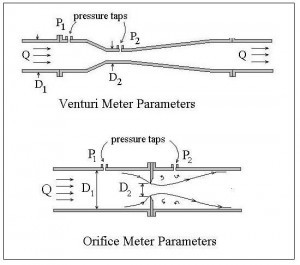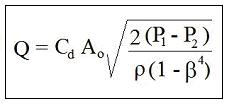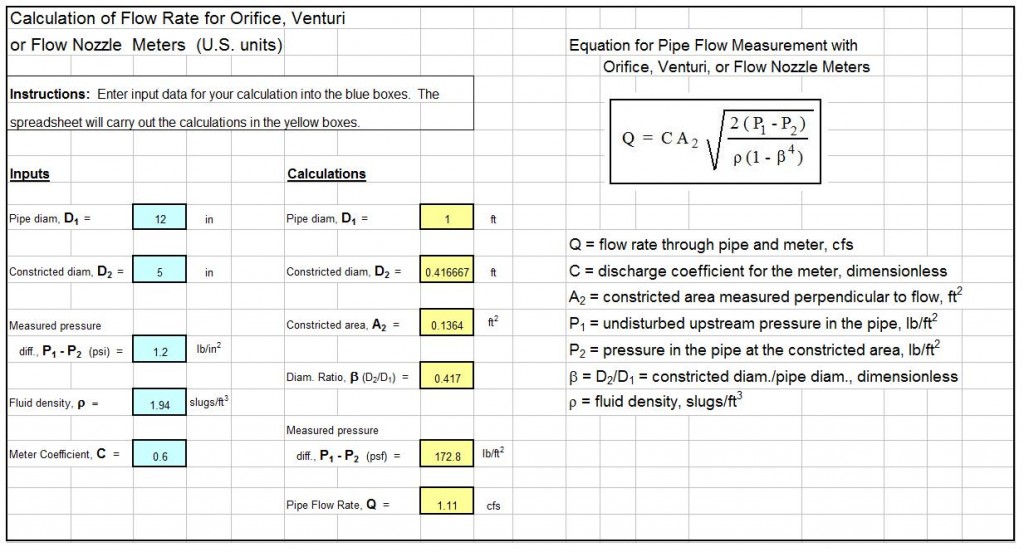Introduction to Orifice and Venturi Flow Meter Calculations Spreadsheet
For an orifice and venturi flow meter calculations spreadsheet, click here to visit our spreadsheet store. Read on for information about Excel spreadsheets that can be used as orifice and venturi flow meter, pipe flow rate calculators.
Excel spreadsheets are convenient for differential pressure flow meter calculations, for meters such as the commonly used orifice flow meter and venturi meter. The general equation for differential pressure flow meters can be built into the spreadsheets with Excel formulas. Also, for gas flow, the ideal gas law can be used to calculate the gas density based on its temperature, pressure, and molecular weight. An Excel spreadsheet can also be used to calculate the orifice coefficient for anorifice meter with one of the ISO standard pressure tap configurations.
Background for an Orifice and Venturi Flow Meter Calculation Spreadsheet
 Orifice and venturi meters both function by sending pipe flow through a constricted area (the orifice plate or the venturi throat), as shown in the diagrams at the right. Due to the increased fluid velocity passing through the constriction, there will be a decreased pressure at that location. The pipe flow rate can then be calculated from the measured pressure difference between the undisturbed pipe flow and the flow through the constriction.
Orifice and venturi meters both function by sending pipe flow through a constricted area (the orifice plate or the venturi throat), as shown in the diagrams at the right. Due to the increased fluid velocity passing through the constriction, there will be a decreased pressure at that location. The pipe flow rate can then be calculated from the measured pressure difference between the undisturbed pipe flow and the flow through the constriction.
The general equation for calculating f low rate through either an orifice or venturi meter is shown at the left, where the parameters in the equation and their units are as follows:
low rate through either an orifice or venturi meter is shown at the left, where the parameters in the equation and their units are as follows:
- Q is the flow rate through the pipe and through the meter (cfs – U.S. or m3/s – S.I.)
- Cd is the discharge coefficient, which is dimensionless
- Ao is the constricted area perpendicular to flow (ft2 – U.S. or m2 – S.I.)
- P1 is the undisturbed upstream pressure in the pipe (lb/ft2 – U.S. or N/m2 – S.I.)
- P2 is the pressure in the pipe at the constricted area, Ao (lb/ft2 – U.S. or N/m2 – S.I.)
- β = D2/D1 = (diam. at A2/pipe diam.), which is dimensionless
- ρ is the fluid density (slugs/ft3 – U.S. or kg/m3 – S.I.)
Orifice and Venturi Flow Meter Calculations Spreadsheet Screenshot
The image below shows an Excel spreadsheet that can be used as a pipe flow rate calculator, based on the measured pressure difference across a flow nozzle, venturi, or Orifice flow meter. This spreadsheet is suitable when the fluid density is known (as for a liquid) and the meter coefficient, C, is known. For this spreadsheet and another to calculate the density of a gas using the ideal gas law model, click here to visit our spreadsheet store.
1. Munson, B. R., Young, D. F., & Okiishi, T. H., Fundamentals of Fluid Mechanics, 4th Ed., New York: John Wiley and Sons, Inc, 2002.
2. U.S. Dept. of the Interior, Bureau of Reclamation, 2001 revised, 1997 third edition, Water Measurement Manual, available for on-line use or download at: http://www.usbr.gov/pmts/hydraulics_lab/pubs/wmm/index.htm
3. International Organization of Standards – ISO 5167-1:2003 Measurement of fluid flow by means of pressure differential devices, Part 1: Orifice plates, nozzles, and Venturi tubes inserted in circular cross-section conduits running full. Reference number: ISO 5167-1:2003.
4. Bengtson, Harlan H., “Orifice and Venturi Flow Meters: for Liquid Flow and Gas Flow.” an Amazon Kindle e-book.

